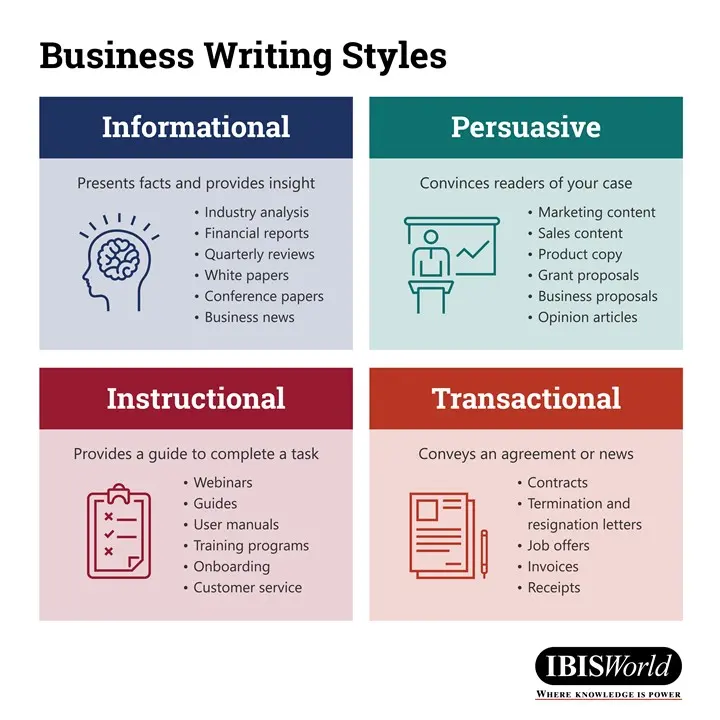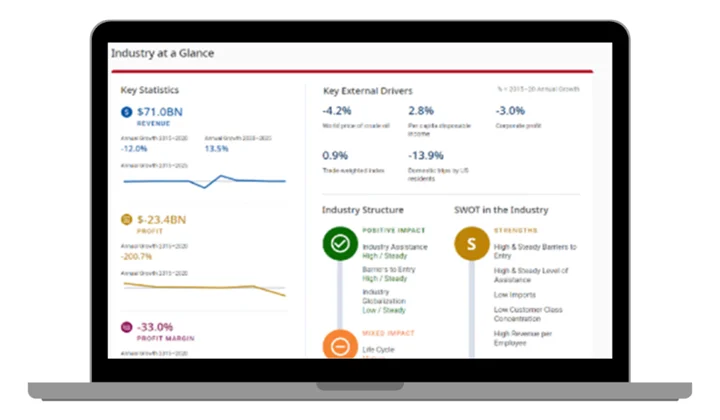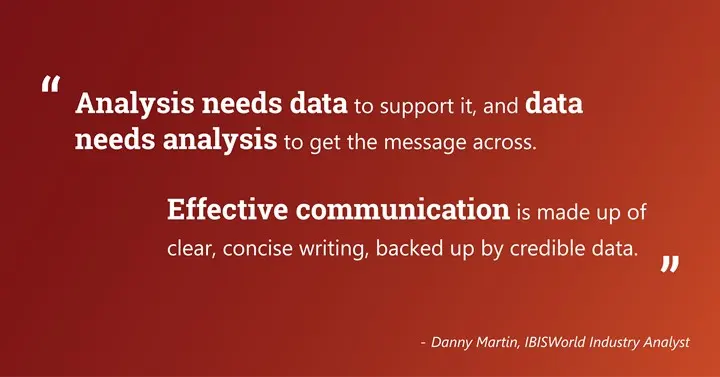Key Takeaways
Effective business writing is segmented, direct and approachable. It will help readers save time and absorb the key messages of your work
Using a reputable source for your data will improve the credibility of your business writing and presentations
Different business writing styles can be used for each type of deliverable, helping you tackle a variety of projects, from industry analysis to opinion articles
What is Business Writing?

Business writing is a method of communication used to educate and inform clients, co-workers and other professional audiences in a written format. Business writing tends to be direct, well-organized and segmented for easier reading. Strong business writing saves readers time and makes them more likely to retain the main messages of your work. For instance, when using business writing in industry analysis, data and insights need to address an abundance of industry characteristics as concisely as possible.
Why is business writing important?
The best business writing successfully communicates your message. You can improve your business writing skills through courses and peer feedback, and support these skills by using business writing templates for different types of written deliverables. Mastering the art of writing concisely and clearly can put you ahead of competitors, streamline internal and external communications and help you stand out to department heads.
With remote work arrangements on the rise, it’s more important than ever to be able to clearly communicate your ideas, decisions or point of view in writing. This is where effective business writing is key. We’ve been thinking about this a lot at IBISWorld, and we’re getting ready to launch a new style of writing to better communicate with our clients. So, what is business writing, and how do you do it well? Let’s get stuck in.
What does your audience want?
Straight off the bat, your readers want to know why they should continue reading. They want solutions that move the needle. To do this, you must keep your writing direct to add value for clients and co-workers, helping them understand why your ideas – and the research supporting them – have a place in the business. For example, writing a business plan for a loan requires you to make your case clearly and professionally, while referring to supporting evidence.
Well-executed pieces have the additional benefit of being a reliable source of record-keeping. This is because the best writing is logically segmented and concise, avoiding clutter. As a result, readers find these pieces easy to navigate and can confidently find the key points.
How can writers benefit?
From a writer’s perspective, effective business writing will help you communicate your ideas, and educate others to make clear and quick decisions. Developing a strong reputation by communicating clearly through your writing helps you earn respect in the workplace and may provide new opportunities.
In addition, industry analysis should be used to support business writing with credible, relevant data sources, to demonstrate accuracy and authority. Credibly referenced writing also has greater capacity to influence downstream business decisions.

When and why should you use the business writing styles?
Informational
You should use informational business writing to provide readers with insight, prioritising the clarity and efficiency of the document. Informational business writing tends to present facts about a topic from a neutral perspective.
Strong informational business writing helps readers navigate and understand the most important information about the topic. It’s important to format such a piece logically to help convey key data insights. The most valuable informational pieces often open with a summary section covering the key points of communication then get more specific in detailed sections later in the piece.

Let’s look at industry analysis as an example. A clear, concise summary is helpful to present high-level information up front. However, this doesn’t mean you should leave out the data or skip the deep dives. Tailoring your industry analysis to reflect the needs of your audience ensures that your reader retains your message and can incorporate it into their work with confidence.

Ask yourself: What do your readers want to know? How you can add value with your piece of business writing? Maybe your reader wants an expert perspective on a specific analysis. Alternatively, they might want an information hub, a piece that touches on all the general information surrounding a topic.
Informational business writing examples:
- Industry analysis
- Financial reports
- Quarterly reviews
- White papers
- Conference papers
- Business news & current events coverage
- Meeting agendas
- Industry research reports
- Information Hub
Persuasive
Sometimes, you need to convince your reader of your premise. Persuasive business writing supports you in making your case, whether it be to your clients, your co-workers or your investors. This style requires a strong knowledge of the audience, as you need to convince them to be open to accepting your proposal.
In addition, your persuasive business writing is made stronger by accurate, unbiased data presented throughout your work. As an example, check out this article from MacroBusiness that uses IBISWorld to support its claims.
When operating from a persuasive business writing template, you need to incorporate authoritative, emotional and logical appeals. For example, product development teams in the Soft Drink Manufacturing industry need to use industry research to get up to speed on market sizing. This process will strengthen their understanding of consumer preferences and how to present the most convincing arguments to Supermarkets and Grocery Stores. The best pitches present a factual basis, incorporate a reputable source and address a solution for what the reader wants or fears.
Ask yourself: What sets your premise apart? It might be a new idea or product that specifically deals with the changing trends of your dynamic environment. Alternatively, it could be a proven strategy used by your competitors that can be adapted to suit your business and address your reader’s needs.
Persuasive business writing examples:
- Marketing content
- Sales content
- Product copy
- Grant proposals
- Business proposals
- Press releases
- External newsletters
- Opinion articles
Instructional
Have you ever followed a recipe while cooking and found yourself confused about the order of tasks, or how to execute a certain step? If so, you’ve encountered instructional writing that could use a little extra work – and you’ll know how important clarity is when laying out instructions for a reader to follow.
The instructional business writing style is used when you want to direct your reader to complete a task. The best instructional business writing can establish your business’s brand as being reliable and credible. You should provide clear and concise instructions; ideally, the reader shouldn’t require additional context to successfully complete the task. Instructional writing often includes numbered lists and visual examples of step-by-step progress, and may include links to other supporting material. You can also help your reader by preemptively flagging problems that they might run into, and providing solutions.
Ask yourself: How do you want your reader to use the information you provide? How best can you guide them? For example, you could write strict guidelines for them to follow, such as in user manuals. You could also deliver flexible instructions to be used only as a point of reference, as can be found in a webinar.
Instructional business writing examples:
- Webinars
- Guides
- User manuals
- Memorandums
- Customer service communications
- Training programs
Transactional
Also known as conversational business writing, you should use this communication style with colleagues, across management levels and occasionally for external business operations.
This style of business writing tends to be the most common, making it arguably the most important to master. Transactional business writing is flexible and can be used in several scenarios, such as to convey good news and bad news, or finalize an agreement.
The tone of transactional business writing varies, and you’ll need to adjust it based on the context of the communication. For example, your emails to your colleagues can likely be pretty casual. However, you should take a more formal tone for anything you’re sending to an external reader, or where the document might be referenced down the track, like an agreement or contract. It may feel overly formal, but it’s important that the record of these transactions leaves as little as possible up for interpretation.
Ask yourself: How often do you make professional assumptions based on the communication of others? What impression does this writing give the reader? First impressions from email communications can be long lasting. Importantly, unprofessional looking business proposal letters can drastically hurt your chances of settling business agreements.
Examples of transactional business writing:
- Termination and resignation letters
- Job offer letters
- Business proposal letters
- Invoices
- Receipts
- Checkout documents
- Contracts
How to produce good business writing
- Decide on the business writing style needed. (What is your goal?)
- Identify the key information your audience needs. (Who, What, When and Where?)
- Outline and address key points and provide appropriate evidence.
- Edit and refine your writing to make it more precise.
- Consistently review your business writing process, make it more efficient. (For example, create templates for the different styles).

Business writing skills
Honing your business writing skills to incorporate credible industry analysis can improve communication and avoid time-wasting queries or revisions.
Improving your business writing takes practice and more than a few tips and tricks.
Some of the basics to keep in mind:
- Write from a reader’s perspective. Ask yourself what you would want to read and go from there.
- Create writing templates and collect examples from thought leaders and other reputable sources.
- Identify ‘problem’ or ‘discouraged’ words that can undermine your writing goals, then compile them into a checklist for all writers to reference and add to.
- Being able to easily reference a checklist of discouraged or problem words will help ensure your language is engaging and suits your audience.
- Despite the importance of conciseness, don’t sacrifice quality for brevity. Providing sufficient evidence to support your propositions will help you drive toward an outcome, not detract from it.
Final thoughts
Professional writing is important for a variety of business situations; we do it every day. For the best results, focus on writing with clarity informed by strong analysis. Use these business writing tips to enhance your writing, to make the process easier for you, and increase the value of your work for your readers.
Source from IBISWorld
Disclaimer: The information set forth above is provided by IBISWorld independently of Alibaba.com. Alibaba.com makes no representation and warranties as to the quality and reliability of the seller and products.




